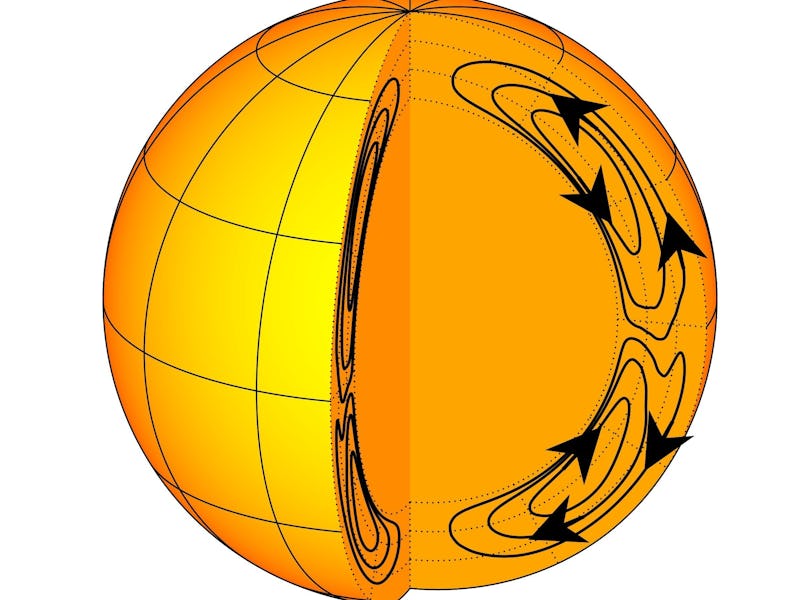Astronomers listen to the Sun's sound waves to crack its mysterious cycle
A new study is the most comprehensive map of plasma flows to date.

Beneath the Sun's outer shell, a layer of highly ionized, boiling hot gas flows all the way down to 200,000 kilometers below the surface of the star. Temperatures of this plasma can reach up to 45,000 degrees Fahrenheit, so hot that most of its atoms break apart into electrons and ions.
The solar plasma is constantly flowing in different directions below the surface of the Sun, and may hold the key to figuring out the star's mysterious 11-year cycle. Which is why a team of scientists have mapped out the plasma's flow, and found a pattern that could explain solar activity.
The study was published this week in the journal Science.
Solar cycle
Every 11 years, the Sun embarks on a new solar cycle which scientists believe is controlled by the Sun's magnetic field.
The Sun’s magnetic field goes through a periodical cycle in which the south and north poles essentially switch spots. Solar activity varies throughout the cycle as the Sun periodically ejects boiling-hot plasma, in the form of solar flares and solar wind, out into space.
The midpoint of the solar cycle is when things really pick up, with the Sun's activity increasing and that means more solar flareups and outflow of radiation from our host star. However, as this solar cycle winds down, the Sun becomes less active.
But until now, scientists are still not sure what controls the Sun's 11-year cycle, but it could have something to do with solar plasma.
During the solar maximum, the point during a solar cycle where the Sun is most active, arcs of hot plasma reach further out into the Sun's atmosphere and they later subside during the solar minimum.
“Over the course of a solar cycle, the meridional flow acts as a conveyor belt that drags the magnetic field along and sets the period of the solar cycle”, Laurent Gizon, director of the Max Planck Institute for Solar System Research, and lead author of the new study, said in a statement.
Solar flares erupt from the Sun's boiling hot surface and flow out into space.
Plasma flow
The team of scientists behind the new study wanted to draw out the geometry and amplitude of motion in the Sun's interior in order to understand the magnetic field of the star.
In order to map the plasma flow, the scientists listened in to the sound waves of the Sun.
Solar sound waves can be observed through telescopes aimed at the Sun's surface as they create certain motions, and the sound waves are excited by the process of convection caused by plasma.
For this study, the researchers looked at sound wave observations that flowed in the north-south direction through the interior of the Sun. As the sound waves get excited by the plasma, they travel faster along with the flow of plasma and slower when they are going against the flow of plasma.
The difference is less than a second long, therefore it had to be measured very carefully.
After analyzing the data, they found that the plasma goes around in one gigantic loop in each of the Sun's hemispheres. This trip around the hemisphere takes 22 years to complete, flowing towards the equator at the base and towards the magnetic poles at the surface. Solar activity, marked by sun spots, increase closer to the equator as the solar cycle progresses.
Therefore, half of the plasma's trip around the hemisphere is marked by one solar cycle where activity increases near the Sun's equator.
“All in all, our study supports the basic idea that the equatorward drift of the locations where sunspots emerge is due to the underlying meridional flows,” Robert Cameron, a researcher at the Max Planck Institute, and co-author of the study, said in the statement.
However, while the study may have resolved one underlying mystery regarding the solar cycle, it also uncovered new mysteries about our host star.
“It remains to be understood why the solar meridional flow looks like it does, and what role the meridional flow plays in controlling magnetic activity on other stars,” Cameron added.
Abstract: The Sun’s magnetic field is generated by subsurface motions of the convecting plasma. The latitude at which the magnetic field emerges through the solar surface (as sunspots) drifts toward the equator over the course of the 11-year solar cycle. We use helioseismology to infer the meridional flow (in the latitudinal and radial directions) over two solar cycles covering 1996–2019. Two data sources are used, which agree during their overlap period of 2001–2011. The time-averaged meridional flow is shown to be a single cell in each hemisphere, carrying plasma toward the equator at the base of the convection zone with a speed of ~4 meters per second at 45° latitude. Our results support the flux-transport dynamo model, which explains the drift of sunspot-emergence latitudes through the meridional flow.